Introduction
The Islamic Republic of Afghanistan is located in south-western Asia and shares borders with 6 countries. Turkmenistan, Uzbekistan, Tajikistan, and China are on the north and northeast, Pakistan is on the south and southeast, and Iran is located on the west. Covering about 650,000 square kilometres of mountains and deserts, this country is home to 29 million people, most of whom are Pashtun Sunni Muslims. The country is mostly rural, with only 23% of its population located in urban centres, including the 3.5 million in the capital of Kabul.
Constitutional history
Afghanistan, sitting along the Silk Road trading link between the East and the West, has always been a politically charged area of the world. Alexander the Great, Genghis Khan, and the Persian armies, amongst others, all attempted to conquer Afghanistan until the 18th century when the Afghani Shahs took over the rule of the area. After the two Anglo-Afghan wars in 1839 and 1878, the British invaded Kabul in 1837, however, over fears of Prussian and Russian influence over the territory. The British left in 1881, and Afghanistan became a buffer zone between Russia and British-occupied India. Afghanistan was not given actual independence until 1919 under the Treaty of Rawalpindi, but a treaty of friendship was signed the same year with the Soviet Union.
In its first years of independence, the Afghani king Amanollah instituted constitutions in 1921 and 1923, but was deposed in 1929 by Tajik rebels. A new constitution was passed in 1931 and 15 years later Prime Minister Shah Mahmud introduced free elections, a free press, and a parliament. In 1952, a coalition of religious conservatives came to power in an era of Cold War tensions. The national parliamentary body, the Grand Assembly, passed a new constitution in 1964 which created a constitutional monarchy and a bicameral legislature. However, the 1970s saw a rash of revolts over social reform inspired by Soviet propaganda. This gave the Soviet Union an opportunity to invade the country, which led to the formation of the mujahedeen, an Islamic resistance group seeking jihad. The mujahedeen continued its civil war until 2001, even though the Russians left in 1989. The tensions also gave rise to the formation of the Taliban, a militant religious group which managed to take control over much of the government.
The Taliban’s refusal to extradite Osama bin Laden, the leader of al Qaeda- the terrorist organization suspected of responsibility for the 11 September 2001 attacks on the World Trade Centres in New York City- triggered American and allied invasion of Afghanistan in November 2001. Following the overthrow of the Taliban by Allied forces, discussions between the international community and representatives of the anti-Taliban forces led to the Bonn Agreement and the a transitional government in 2001. A constitutional drafting commission was charged with writing a new constitution for the country. On 4 January 2004, the Afghan National Assembly ratified the new constitution.
2004 Constitution
The 2004 Constitution was designed to take into account the social, political, and religious dynamic of Afghanistan, and it established an Islamic Republic. The Constitution recognizes Islam as the national religion, commits to the Universal Declaration of Human Rights, and pledges to fight terrorism and narcotics production. Power is divided between the President, the National Assembly, the Grand Assembly, and the Supreme Court.
Executive branch
The constitution provides for a President as the Head of State and two vice presidents. The President is elected by a direct vote to a five year term, and he may run for only two terms. As Commander in Chief, he has the duty to enforce the constitution and protect the independence of the state. He may also convene the Grand Assembly, called the Loya Jirga. Some of his other duties include creating policies with the approval of the legislature, declaring war and states of emergency, appointing ministers and members of the Supreme Court, as well as other high ranking officers of the government and armed forces. He also has the authority to approve laws, grant pardons, and issues honours. Impeachment is prompted by a one-third vote by the lower house of the Legislature, and if two-thirds vote to issue charges against him, then a Loya Jirga is convened to uphold the charges. If the Loya Jirga agrees to the charges by a two-thirds vote, then a special court is created from members of the lower house of the Legislature and the Supreme Court to decide on removal. The President is aided in his task of executing national policy by a Council of Ministers. The Ministers are nominated by the President and approved by the Legislature. The Council has six main duties: to enforce the Constitution and the laws, to protect the dignity and independence of Afghanistan, to maintain public law and order, to prepare the budget and regulate the financial affairs of the country, to devise policy, and to report on their plans and progress to the Legislature every fiscal year. The Council, chaired by the President, has the power to pass regulations in order to carry out these duties.
Legislative branch
The National Assembly is the highest legislative authority in Afghanistan, and is divided between a lower house, the House of the People, and an upper house, the House of the Elders. The House of the People is an elected body whose current 250 members are selected by a direct vote to a five year term. The current 102 members of the House of the Elders are either appointed by the President or elected from local councils to terms ranging from three to five years. Together, the National Assembly is charged with passing and modifying legislation, as well as approving development plans and the state budget. It may also ratify treaties. The House of the People has the additional power to question the Ministers of the Council of Ministers and approve appointments. In cases of disagreement between the houses, the House of the People has the final say on issues relating to the approval of development plans and the budget. Both houses may approve bills, though the President must sign them into law. However, only the lower house may override a presidential veto by a two-thirds majority vote.
The Loya Jirga, or Grand Assembly, is the highest legislative body and is given such an important position because it is seen as the supreme manifestation of the popular will. The Loya Jirga is comprised of members of the National Assembly, along with the chairs of the local councils. The Ministers of the Council of Ministers, the Chief Justice, and the Justices of the Supreme Court sit in the Loya Jirga but lack voting rights. The Assembly is convened only to address issues of supreme national importance. Such issues could relate to questions of national sovereignty, constitutional amendments, and presidential impeachments.
Judicial branch
The Judicial Branch of Afghanistan consists of a Supreme Court, an Appeals Court, and other courts created by law. The constitution gives final authority to the courts’ judgments, requiring them to be enforced as law, though capital punishment cases must be approved by the President. The judicial system reflects the Islamic nature of Afghanistan in that the courts may use Islamic law in cases involving the personal matters of followers of Sharia law.
The Supreme Court is the highest court. It has nine members who are appointed for ten-year terms by the President with the approval of the lower house of the Legislature. A Justice of the Court may be removed by impeachment in the same way as the President. The Supreme Court has the power of constitutional review and may hear cases brought by government bodies. The Court is also charged with overseeing the appointment, dismissal, and promotion of judges and personnel of the other courts. In the performance of this duty, removal of a judge must be tried before the Court and approved by the President.
Political Challenges
Despite having a stable and functional constitution, Afghanistan continues to face political and governance challenges related to its history of conflict and power struggles between warring factions. President Hamid Karzai was elected by an overwhelming popular vote in October 2004, but his government controls only about 30% of the country. The rest is under the sway of regional warlords, and the parliamentary elections of September 2005 gave the warlords even more power in the National Assembly. This weakened Karzai’s position in the government, while widespread economic hardship weakened his position among the people. There have been accusations that both the warlords and the national government have been benefitting from the opium trade, and that their efforts to assist the international community in halting drug trafficking have been coloured by corruption. Recently, two of Karzai’s advisors, including his half-brother Ahmed Wali Karzai, were assassinated, raising doubts about the stability of the Afghan government as the Americans prepare to withdraw from the country by 2014.
The remnants of the Taliban have been using the situation to rebuild in the areas outside of government control, particularly in the southeast. It has also been using safe havens along the Pakistani border to evade international troops. Despite a successful NATO effort to push back the Taliban from an assault on Kandahar, it was estimated in 2008 that the group controlled nearly 10% of the country. It is supported by revenues from opium production, taking advantage of the instability of the nation, the weakness of the government, and the corruption of local officials. With these revenues, the Taliban can pay for smuggled weapons, recruits, and other supplies that fuel the growing religious insurgency. In an effort to fight these policies, the US authorities in particular have begun to implement similar measures for legitimate crops like grapes, saffron, and especially wheat to feed the population of Afghanistan. In addition, the Afghan government has been indicating its desire to begin talks with Taliban leaders, though there has been little response from the rebel group on the matter.
-
According to the Afghanistan Research and Evaluation Unit’s report from 2011 one of the most important tasks currently is to assist the Afghan government to “develop robust, effective and accountable mechanisms for the operation of local government”, since too much attention has been spend on building a strong centralised state at the expense of the local government at the provincial and district level. Hence, the Unit calls amongst others for a modification of the 2010 Draft Legislation on Local Government to provide meaningful powers to provincial and district representative bodies, an allocation of responsibility to a single executive authority for the administration of all tiers of local government, and more powers of the Provincial Development Comittees.
-
Strengthen the legitimacy and trust in formal justice systems. Many disputes are being resolved according to customary law intermixed with Sharia law, although most of the serious crimes are being referred to the state by now. In regard to the community-based dispute resolution, questions over human rights and the treatment of women remain. The formal justice system on the other hand faces considerable shortcomings regarding the time of a process, distance, complexity, expense and corruption.
-
Giving more power to the provinces. Afghanistan is a very decentralised country, however, the constitution of 2004 imposed a system of government giving much power to the president. Regionalising power. (German link: http://www.dradio.de/dkultur/sendungen/interview/1102085/)
-
Reforming and strengthening state institutions and establishing genuine constitutional government (http://aussenpolitik.net/themen/sicherheitspolitik/conflict_risk_alert-a...)
-
Further enhancing the cooperation between the military, police and civil forces
-
Empowerment of the civil society to strengthen the transition into a real state of democracy
-
Agreeing on future relations with the United States and other countries. President Hamed Karzai is in conflict with Afghanistan’s parliament over plans for a “loya jirga” or national congress to discuss future relations with the United States. Parliament stated that approving deals like the one proposed with the US were its own prerogative, and calling a loya jirga to do so would be illegal as it would encroach on legislators’ authority. Karzai’s deputy spokesman Siamak Herawi defended the loya jirga plan, insisting that elected politicians would be included in it. (http://www.unhcr.org/refworld/country,,,,AFG,,4e3004d62,0.html)
-
Electoral fraud: The parliament’s position is weakened by the fact that its own legitimacy is widely questioned, following allegations of substantial ballot-rigging in the September election. A five-member special court produced its findings in June, announcing that the recounts it had ordered in several areas where electoral fraud was alleged meant that 62 Wolesi Jirga members must stand down and be replaced by others. Parliament has so far rejected the court’s ruling. http://www.unhcr.org/refworld/country,,,,AFG,,4e3004d62,0.html
System of government under 2004 Constitution
Timeline
| 1919 | Afghanistan and Britain sign the Treaty of Rawalpindi granting independence to the territory after a third failed British attempt to bring the country completely under their control |
| 1926 | King Amanullah attempts to introduce social reforms after the creation of two constitutions |
| 1929 | King Amanullah deposed among opposition to his reforms |
| 1933 | Zahir Shah begins the period of the Afghani Shah monarchy |
| 1953 | General Mohammed Duad named Prime Minister and begins a period of Soviet friendship and social reform |
| 1963 | Prime Minister Duad forced to resign by conservative forces |
| 1964 | Constitutional Monarchy instituted |
| 1973 | Duad stages a coup and institutes a republic, attempts to play the US and the Soviet Union against each other during the Cold War |
| 1978 | Coup by leftist People’s Democratic Party kills Duad and institutes a pro-Soviet government, which leads to the beginning of an armed revolt by conservative Islamic and ethnic leaders in the countryside, provoking the invasion of the Soviet Army to support the Communist government |
| 1985 | Mujahedeen resistance group formed in Pakistan and are supported by American arms |
| 1988 | Peace accords signed between Afghanistan, USSR, and the US, leading to the withdrawal of Soviet troops, but civil war continues between the mujahedeen and the Afghani government |
| 1992 | The mujahedeen forces succeed in removing the pro-Soviet government and form a government under President Burhanuddin Rabbani |
| 1994 | Ethnically Pashtun group, the Taliban, emerges to challenge the government |
| 1996 | Taliban takes control of the capital and instates a hard-line Islamic government while a northern alliance of anti-Taliban forces forms |
| 1999 | US institutes an air embargo and financial sanctions in an effort to force the Taliban to turn over Osama bin Laden, leader of the terrorist group Al Qaeda suspected of bombing two American embassies in Africa in 1998 |
| 11 September 2001 | Terrorist attacks on the United States orchestrated by Osama bin Laden and Al Qaeda |
| October 2001 | US and UK launch air strikes against the Taliban after they refuse to hand over Osama bin Laden |
| 5 December 2001 | Bonn Agreement signed between Afghan groups to create interim government after the Taliban give up their last stronghold of Kandahar, Hamid Karzai becomes the head of the interim government charged with preparing a new constitution |
| 2004 | Loya Jirga adopts a new constitution creating a strong president, Karzai elected President |
| 2005 | First parliamentary elections in over 30 years result in granting more power to local warlords |
| 2006 | Violent anti-US protests in Kabul , southern operation between Taliban and Afghan and coalition forces leads NATO to take command over the security of Afghanistan from an American-led coalition force |
| 2007 | Opium production reached record high |
| 2008 | Taliban rejects peace talks with President Karzai, UK, US, and Germany expand number of troops in the region |
| 2009 | US commits more troops, prompting 20 NATO countries to pledge the same, a restructuring of policy to focus on development of Afghani security forces, and a new southern offensive against the Taliban, President Karzai wins second election marred by allegations of fraud |
| 2010 | Tensions between the international community and President Karzai grow as he accuses the UN election monitoring teams of creating the election fraud |
| 2011 | Civilian casualties reach record high, Osama bin Laden killed by US operation on his compound in Pakistan, Karzai’s half brother and senior political advisor assassinated |
Bibliography
- United States. CIA World Factbook: Afghanistan. , 2011. Web. 8 Jul 2011.
- "Afghanistan Country Profile." 15/03/2011. BBC News. Web. 8 Jul 2011.
- United States Department of State. Background Note: Afghanistan. , 2010. Web. 8 Jul 2011.
- http://www.afghanembassy.com.pl/cms/uploads/images/Constitution/The%20Constitution.pdf
- Maddex, Robert L. Constitutions of the World. 3rd ed. Washington, D.C.: CQ Press, 2008. Print.
- The Secretariat of the Constitutional Commission of Afghanistan. The Constitution Making Process in Afghanistan. 10/03/2003. Web. 18 Jul 2011.
- Rusling, Matthew. ”Death of Karzai’s Brother Stirs Questions over U.S. Strategy in Afghanistan”. 15/07/2011. English.news.cn. Web. 18 Jul 2011.
- ”Afghan President Advisor Killed by Taliban”. 18/07/2011. English.news.cn. Web. 18 Jul 2011.
| Branch | Hierarchy | Appointment | Powers | Removal |
|---|
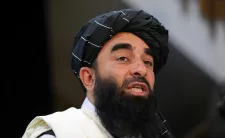
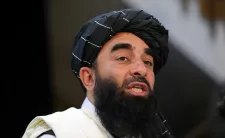
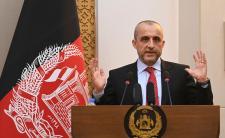
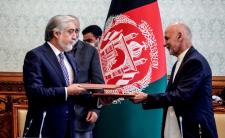

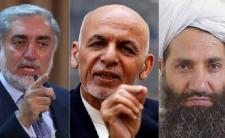
Share this article